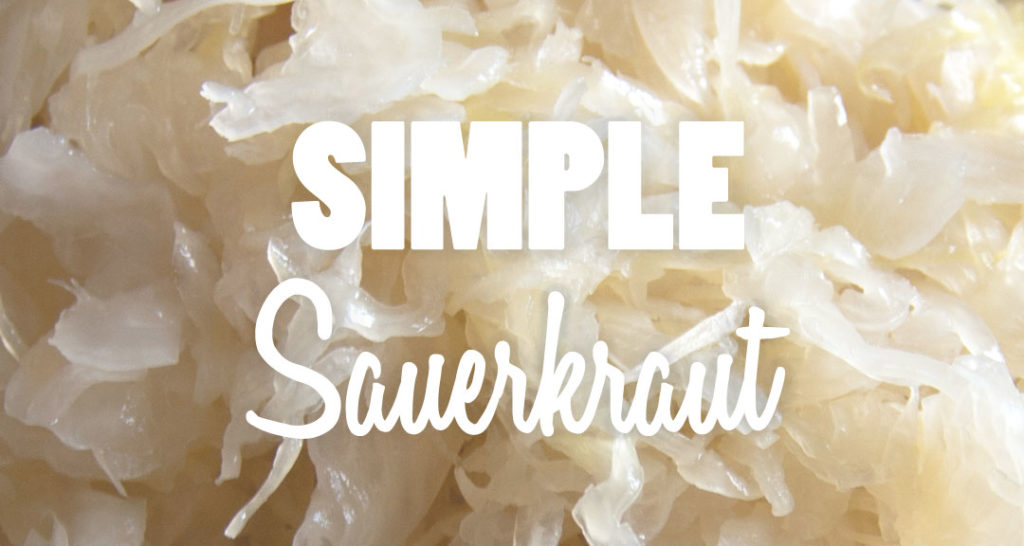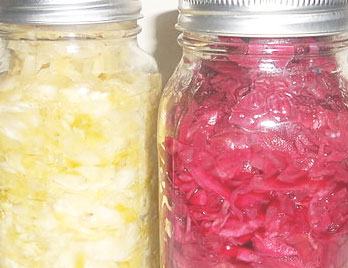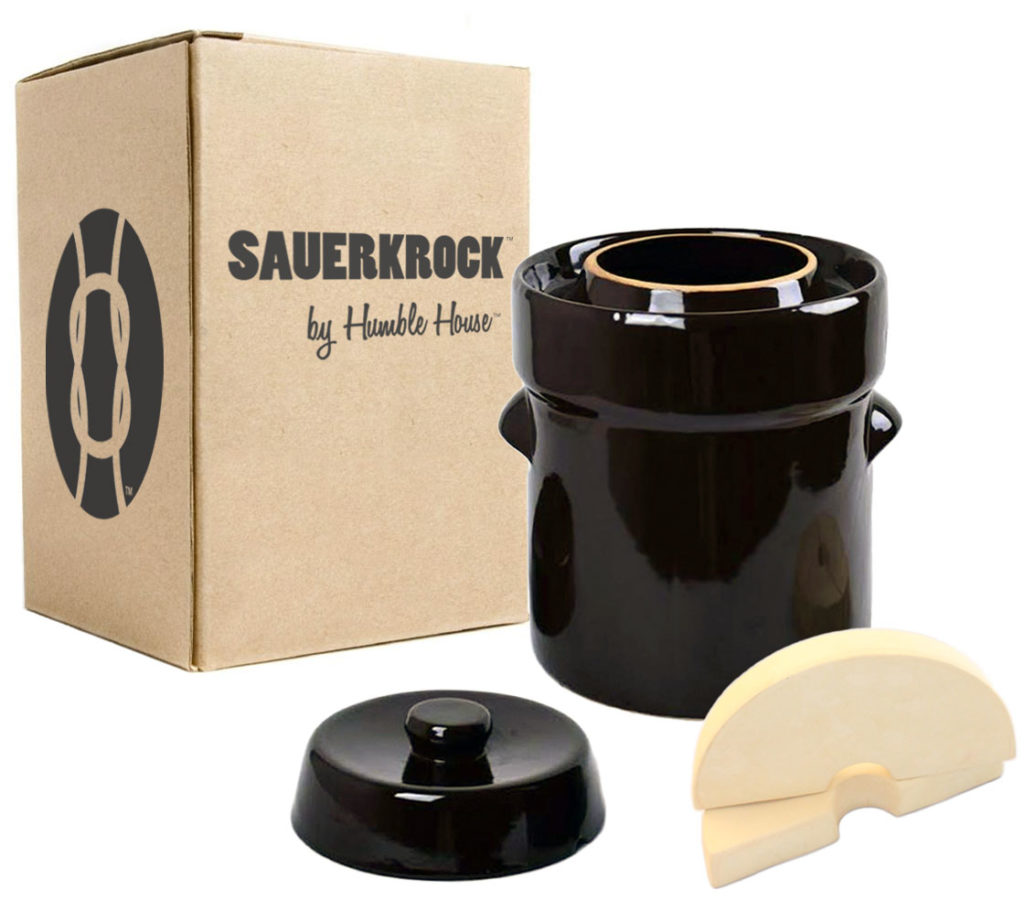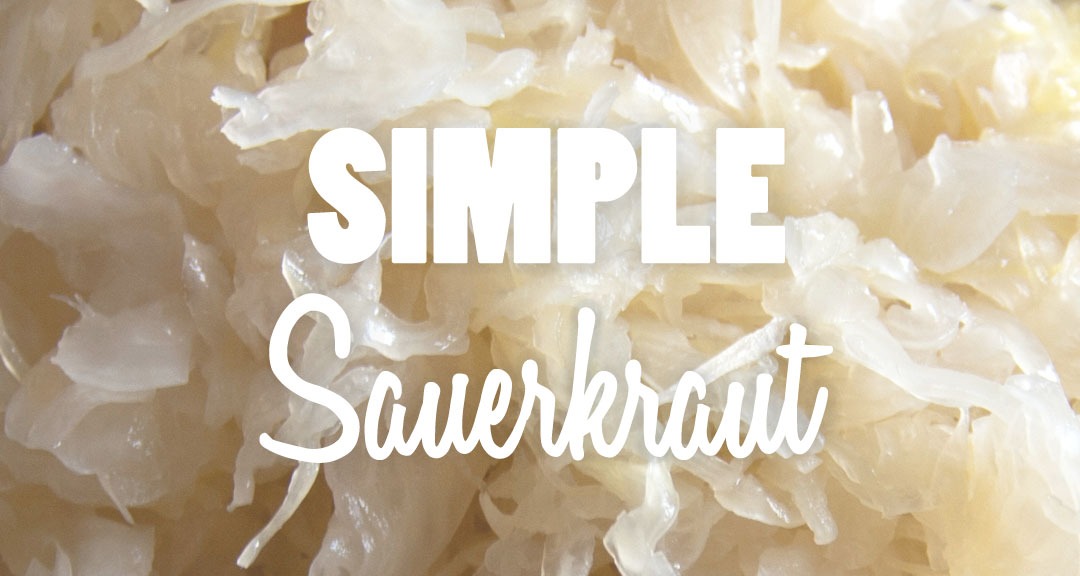
SAUERKRAUT, AKA “SOUR CABBAGE”
Sauerkraut, which literally translates to “sour cabbage”, is a Germanic dish made of finely chopped cabbage that has gone through the lacto-fermentation process, the same process used to make Kimchi and Dill Pickles. That preserving process, which requires the help of unrefined mineral-rich salts, gives Sauerkraut its distinctive sour flavor and long shelf life.
It also gives the original cabbage new health benefits thanks to probiotics from the lacto-fermentation process that improve digestive health, among other areas. And you can still make your Sauerkraut in the same traditional style that has been used for hundreds of years with ceramic fermentation crocks.
Sauerkraut is extremely easy to make and provides a flavorful kick to basic dishes. Traditionally, after undergoing the fermentation process, Sauerkraut is cooked and served warm. Some of our favorite ways to eat warm Sauerkraut are on sausages (like bratwursts or hot dogs) or mixed with mashed potatoes or potato dumplings. Try this simple recipe to make your own Sauerkraut and figure out what your favorite way to eat it is!

SPECIAL EQUIPMENT
MIXING BOWL: You’ll want one large (4 or 5-quart) glass or stainless steel mixing bowl to combine the salt and cabbage before transferring to the fermentation crock. Stainless steel and glass are non-absorbent materials and will not impart any undesirable flavors into your cabbage like plastic. We like the largest bowls from this Pyrex set of bowls or this Cuisinart set of bowls. Both are great sets with lids that you will get a lot of general use out of in the kitchen for cooking, backing, and food storage!
FERMENTATION CROCK: We recommend that you use a traditional ceramic fermentation crock, like the SAUERKROCK by Humble House, instead of mason jars for all food fermentation recipes and we have documented the reasons for this in detail in this blog post. The main reason for this is that mason jars and other clear glass vessels allow light and UV rays in which can be harmful to the fermentation process cause damage to your fermenting food.
CABBAGE TAMPER: A sauerkraut pounder is truly an asset when it comes to making a successful batch of Sauerkraut because it increases the amount of brine extracted the cabbage. More brine means a better chance your fermenting cabbage is completely covered in liquid and less chance of mold or spoilage. You will want one long enough for use with a crock like the SAUERSTOMPER by Humble House which is specifically designed for people who ferment in a Sauerkrock and store in mason jars.
STORAGE JARS: After the Sauerkraut has completed the lacto-fermentation process, you will need to transfer it over to mason jars for refrigerator storage. We’ve found that wide mouth mason jars make for the easiest transition and best storage solution and recommend either the quart-size like these ones or half-gallon size like these ones. The Sauerkraut produced by this recipe should fit in two quart-size jars or one half gallon-size jar.
PLASTIC GLOVES: Gloves are totally optional, but we recommend food grade disposable poly gloves like these ones if you don’t want your hands to sting from massaging the salt into the cabbage!
REQUIRED INGREDIENTS
Makes approximately 2 quarts of Simple Sauerkraut
- Sauerkrock “City” = 2 liters (recommended fill is 1.5 liters)
- Sauerkrock “Original” = 5 liters (recommended fill is 4 liters)
- Sauerkrock “Family” = 10 liters (recommended fill is 8 liters)
Ingredients List
- 1 large (5 pounds) green or red cabbage
- 3 tablespoons mineral-rich dry salt*
*We do not recommend using standard table salts or kosher salts because they are refined and often contain additives. The best salts we’ve used for making Sauerkraut and other fermented foods are Real Salt brand sea salt and varieties of Pink Himalayan Salt. These salts are natural and unrefined, which means they contain no artificial ingredients and maintain all of their original minerals which add to the quality and flavor of your recipe.

INSTRUCTIONS
PREPARE THE CABBAGE
Remove the wilted outer leaves of cabbage and discard. Cut the cabbage into quarters to expose the core, then trim out the core and discard. Very finely chop, or even grate, the cabbage that is remaining and move it into a large mixing bowl.
Add the salt to the mixing bowl then thoroughly massage the salt into the cabbage with your hands (wear gloves if desired) until it is noticeably softer to touch.
FERMENT THE CABBAGE
Transfer the softened cabbage into your fermentation crock in layers, packing it down with a sauerkraut pounder with each layer to maximize the amount of brine that is extracted from the cabbage. Make sure the Sauerkrock is filled no more than 3/4 full in order to leave room for the ceramic weights.
Set the weights on top of the cabbage and push down lightly to ensure the fermenting food stays submerged in the brine that develops during the lacto-fermentation process. Place the lid on the Sauerkrock, fill the water channel water, then tuck the crock away in a low-traffic area (like the inside corner of a kitchen countertop) in order to avoid being disturbed while it ferments.
Let the mixture sit in the Sauerkrock at room temperature for anywhere from 2 days to a whole week depending on how sour you like your Sauerkraut. Don’t forget to check the water channel regularly to ensure enough water remains after evaporation to keep a seal.
CAN, REFRIGERATE, AND ENJOY
When the Sauerkraut tastes good to you, move it into wide mouth mason jars after straining out the excess liquid. Next? Refrigerate and enjoy!
Sauerkraut continues to develop its flavor even during refrigeration and can last for months thanks to the preserving power of lacto-fermentation.
DO YOU HAVE QUESTIONS, SUGGESTIONS, OR REQUESTS? LEAVE A BLOG COMMENT BELOW!


Thank you for quickly outlining why using other salts aside from pink himalayan and sea salt is not beneficial for the process – I’ve always wondered this. I didn’t know there were that many additives in normal kosher salt. I love the picture you have that outlines the stark contrast between yellow and red cabbage! I don’t know which one to choose – My Grandpa always used yellow and this is the type we always had with our family dinners, but I’m more than happy to try the non-nostalgic way and shoot for red cabbage! Thanks for your article and recipe!
Hi Billy,
We’re glad you enjoyed our post and learned something new from reading it! It is probably worth us posting an article just on the different types of salt that are available and why they would or would not be suitable for using with fermenting foods as it is certainly something that is not commonly known.
If you liked this recipe, we have several other foundational fermented foods recipes here on our website and plan to release several more in the coming months.
Happy Fermenting!
The Humble House Team
Can I assume that this recipe is for the larger 5L crock? If I have the smaller one, should I just cut this recipe in half?
Hi Bud,
Our recipe for Simple Sauerkraut yields approximately 2 quarts (or a half gallon) of Sauerkraut which would fit in the 5L Sauerkrock “Original” with the weights and plenty of room to spare. Halving this recipe would be appropriate if you are using the 2L Sauerkrock “City” fermentation crock. In that case we recommend using either a small cabbage (around 2 pounds) or a portion of a larger cabbage head.
Hope this helps and happy fermenting in the new year!
The Humble House Team
I have always heard not to use stainless? Is this an old wives tale?
Hi Eadie,
Not all metals are appropriate for use fermenting foods and beverages, but stainless steel is an approved and often preferred material for home fermentation vessels. It is an especially commonly used material amongst home and industrial beer brewers alike. Stainless steel is a non-ferrous (does not contain iron) and non-reactive material so you do not need to worry about leeching or corrosion when using it.
Hope this addresses your concerns!
The Humble House Team
Should the salt be finely ground or coarse?
Hi Lauren,
Whether the salt is fine or coarse should not matter quite as much as what kind of salt. You definitely want to use unprocessed or unrefined salt for fermentation. We definitely do not recommend Table salt, Kosher salt or the like. We recommend Pink Himalayan Salt or Real Salt!
Hope that helps.
Happy Fermenting,
The Humble House Team
Can i just add some cucumber slices mixed in with this recipe, perhaps maybe some garlic as well? (open to other suggestions as well) Or is there more to it than that?
Hi Alex,
Once you get the basics of this recipe down, you can definitely add a few more things like cucumber and garlic in to add some additional flavor.
Additionally, try browsing through some more recipes over at our friends at http://www.fermentationrecipes.com!
Happy Fermenting,
The Humble House Team
I have just started my first batch of sauerkraut in my new 2L Sauerkrock. After prepping the cabbage, tamping it and applying the weights, the crock is only filled about 1/4 of the way. Does the Sauerkrock have to be filled all the way for good results? Will I have any problems with so small a batch?
Hi there,
We don’t think how filled your SAUERKROCK is matters quite as much as if the cabbage is submerged under the brine/ weights. If this is the case, you should be ok. Let us know if you have any additional questions.
Thanks and Happy Fermenting!
The Humble House Team
Is there a reason why the water from the water seal might get sucked into the crock?
During our fermentation period overnight the trough was almost dry. Previous and after we didn’t have that happen. Can you explain how or why that could happen?
Hi Cathy,
Some evaporation of the water seal is normal during the fermentation process, especially depending on the climate. This should not affect the batch and we suggest adding more water to the seal every few days if this continually occurs. Additionally, many folks add a thin layer of cooking oil on top of the water seal so it does not evaporate, but still keeps an airtight seal.
Please do not hesitate to reach out to us for any additionally troubleshooting you may require with your ferment.
Happy Fermenting,
The Humble House Team
The anomaly that I am describing would not have been from evaporation. I have read other online posts that discuss a vacuum that could possibly be created sucking the water from the seal into the crock. Is that possible? and if so, how do you prevent it? The instructions that came with our crock didn’t denote how full we could fill the crock or say anything about how much water to put in the seal. Can you put too much water in?
Hi Cathy,
We are also thinking that your ferment is creating a vacuum and sucking in the water from the seal.
Our recommendation is to put an inch or two less into the crock and try that. That should create less of a vacuum wanting to pull in the water from the seal.
Let us know how that works!
Happy Fermenting,
The Humble House Team
Make sure you maintain constant temperature. If the crock is warm, or your contents are warm, it will create a vacuum as the contents cool to room temperature. I had this issue brewing beer, and just postponed adding the airlock until the liquid was closer to room temperature.
I have a 5 liter crock and followed the instructions for my first batch. Made sure the channel was full. Used the weights provided. When I finished putting the cabbage in the crock and tamping it down, it seemed like there was enough brine, and the cabbage was below the brine with the weights on top. After a week, when I checked it, there wasn’t any brine at all in the bottom. It didn’t smell bad, but in an abundance of caution, I tossed it, very sadly. Any tips on what I might have done wrong?
I had the same experience….and have this same question. I finished my batch today and when I opened the crock, found there was less brine then when I started…which makes sense since the weights absorb liquid…but wondering a) how much liquid should we have to start; b) how much liquid should there be after a week; c) in the instance as described above if I skimmed off the top layer of the kraut, the remaining kraut should be fine, yes? There was some liquid present after a week, but the weight/cabbage was definitely not submerged in liquid. There was not any mold, it smells like kraut, looks delicious, and the few bits I nibbled on taste very good. Just very curious about other’s experience with this, and also how/when do we know if the batch is actually bad.
Are you sure the salt is right in this recipe? We had to throw it out. Was so salty, none of us could eat it.
My weights had mold on them after my first use. I scraped it off and washed the weights and the crock in hot soapy water (not dishwasher) but they still have mold-colored spots on them. I poured boiling water over them and just start d another batch of sauerkraut but I’m wondering if they are safe to use or if I should replace them.
Hi Ruth,
We would recommend following the steps in our page here:
http://humblehouse.co/clean-ceramic-fermentation-crock-weights/
Happy Fermenting!
The Humble House Team
Hi! The link seems to be dead or incomplete. Can you repost it? I’m having a similar problem with mold.
Hi Anthony,
Just fixed the link in the previous comment – oops, our bad!
Here it is again for you: http://humblehouse.co/clean-ceramic-fermentation-crock-weights/
The Humble House Team
I used a different recipe than yours because the other recipe explained that the ratio of salt to cabbage was 2% by weight and the cabbage I was working with was quite big and therefore didn’t conform to a standard cabbage from the market. Anyway, the recipe I was using said to check it after 2 – 5 weeks. Your recipe says 2 days to a week. That is a big difference in when to check it. After I chopped up the cabbage I weighed it to get the salt proportions right and the total amount of cabbage I salted and packed in my 5L crock was 7 1/2 lbs of cabbage. It fit well into the 5L crock. After 1 day it started to release air bubbles from inside the crock but now, 4 days later, it is no longer releasing bubbles. Is this what I should expect to happen? And how long should I ferment it? How will I know it is ready?
I am living in the tropics so my ‘room temperature’ is around 30 degrees. For the Saurkraut recipe, do you recommend leaving the fermentation process still at room temperature, or in the fridge? Any other tips regarding high ambient temperature and food fermentation is great.
Just for reference, I also brew Kombucha (have just purchased your crock) and leave that at room temperature, which goes well. Thank you!
Hi Stéphanie,
Wow, that is very warm indeed! Kombucha thrives in warmer temperatures which is why many people end up buying heaters for their Kombucha crocks to keep the contents in the 80s (Fahrenheit), however Sauerkraut is a bit more difficult to manage at that temperature. A warmer climate speeds up the fermenting process so you can be successful fermenting it at these temperatures, but just need to note that the fermenting time required is likely considerably less than most recipes call for.
You can also keep the crock in a basement or a closet if you are trying to achieve a cooler temperature and slower ferment, but a refrigerator would be too cold. It could take a few months to achieve the same fermentation level in a refrigerator that you could achieve in your tropical room temperature in a few days!
The Humble House Team
I see recipes say to use a wooden spoon, can I use my 6 quart Kitchenaid mixer to stir the salt in the cabbage before I put it in my Sauerkrock? Does the bowl I use have to be glass or ceramic?
Hi Jerry,
We would worry that using a mixer of any kind would pulverize the cabbage too much and you’d end up with mushy Sauerkraut. We recommend hand-mixing so that the cabbage gets fully coated with salt but retains its structure and crunchiness when finished. Wooden spoons work great for this but so would a silicone spatula or any other large mixing spoon.
We generally prefer glass, ceramic and stainless steel bowls over plastic because they are non-porous and hardier. Plastic tends to degrade over time, leaching chemicals and “plasticky” flavors into your food. Plastic also can harbor bacteria and retain flavors and smells of previous food contents, increasing the likelihood of contamination of your batch.
Fortunately, these are generally only problems if you are leaving the food in the plastic for an extended period of time. Some recipes call for soaking vegetables in a brine prior to fermenting and we would not recommend plastic for that. Due to the limited amount of exposure to a bowl that this recipe calls for, you should be fine using a plastic so long as it is clean and intact.
The Humble House Team
Do I have to use a wooden tamp? The reason I ask is that I have a plastic tamp from my Vitamix that I think I use… And the reason I say think is because I’ve never made sauerkraut before and this would be my first time .
Hi Sandy,
You do not have to use a wooden sauerkraut pounder if you have another comparable tamper made of a different material. The reason we recommend wood is that it is a softer material than other tampers out there made of metal, hard plastic, etc. and is unlikely to cause damage to a ceramic crock which is more fragile than a plastic / glass Vitamix. As long as you are not banging it against your Sauerkrock, you should be fine!
The Humble House Team
I followed the recipe but my cabbage didn’t make much water/brine. I tamped it down but it wasn’t fully submerged. I used the crock and the weights and kept it sealed. After two weeks I tamped it down again to get it under the brine. The cabbage is pink. Is that ok?
Hi,
Added the salt and let it sit.
Put in crock then tamped it down. Brine does not cover cabbage. Any suggestions?
We like Trader Joe’s sauerkraut that has pickles in it.
I want do that.
Should I add the pickles before fermentation or after?
Can I add more vegetables part way through the fermenting process? If so, do I mix them down into the existing fermenting cabbage?
I’d like to “can” the Kraut after it ferments to save frig room. Pros? Cons? Any suggestions. I’m a first time Kraut maker with your 5L crock, very excited to use your product correctly! Crock On!
Can’t wait to start using a Humble House Sauercrock for my lacto-veg! I’ve been using quart jars and have been happy with that but love the idea of an old fashioned looking crock. It looks like an easier process having the weights and the water channel lid. I’m trying to decide on which size to get.
My questions are… #1 How many pounds of cabbage does it take to fill the 2 liter and 5 liter crock?
#2 I like to mix cabbage and cauliflower, will that work just as well in the crock?
#3 I always pounded the daylights out of my cabbage before putting into the containers but I don’t see that step in your recipe. Is pounding not required for fermentation in the crock?
#4 I always save a bit of the lacto rich brine after fermenting and added it to the next batch when I make it. Is this safe?
Don’t forget to check the water channel regularly ? Why do I even need to put water in this channel? Kraut makes it’s own brine & keeping it sealed should keep the brine in, Right? This is the first time using your sauerkrock. I should not need to add any water, right? Also I’ve always used canning salt. What is your opinion on using that?
So I’m making my first batch in the new crock I bought from you. Its been going about 4 weeks. I noticed the other day 4 small bluishgreen mold spots on the top of the liquid. I fished them out. It smells fine. Is it ok to continue? If so do I just drain it into a strainer and then put in ball jars? Thanks.
Just tried my first sauekraut in my new Humblehouse crock. I checked it after a week and saw small bits of white and blue mold? floating on the top of the brine. I used sea salt. Is the batch ruined or can I remove them and continue to ferment>
I’m about to pull a batch (my first) of sauerkraut from the crock. Another will be going in as soon as I prep it. Is it necessary to wash out the crock and bleach the stones? The crock will be closed as it waits.
I have the 2L crock and tried to figure out the ratio of cabbage and salt. Obviously, I got it wrong! . It is way too salty. Is there a way to save the sauerkraut? It has been fermenting for 3 days now. Can I add water to it or drain it? I really don’t want to have to throw it out. Thank you.
Since the crock is to be left undisturbed & un opened, how will I know when the fermentation process is complete?
I let my batch ferment 2 weeks. Is there any harm letting it ferment longer than what your recipe says, 2 day- a week?